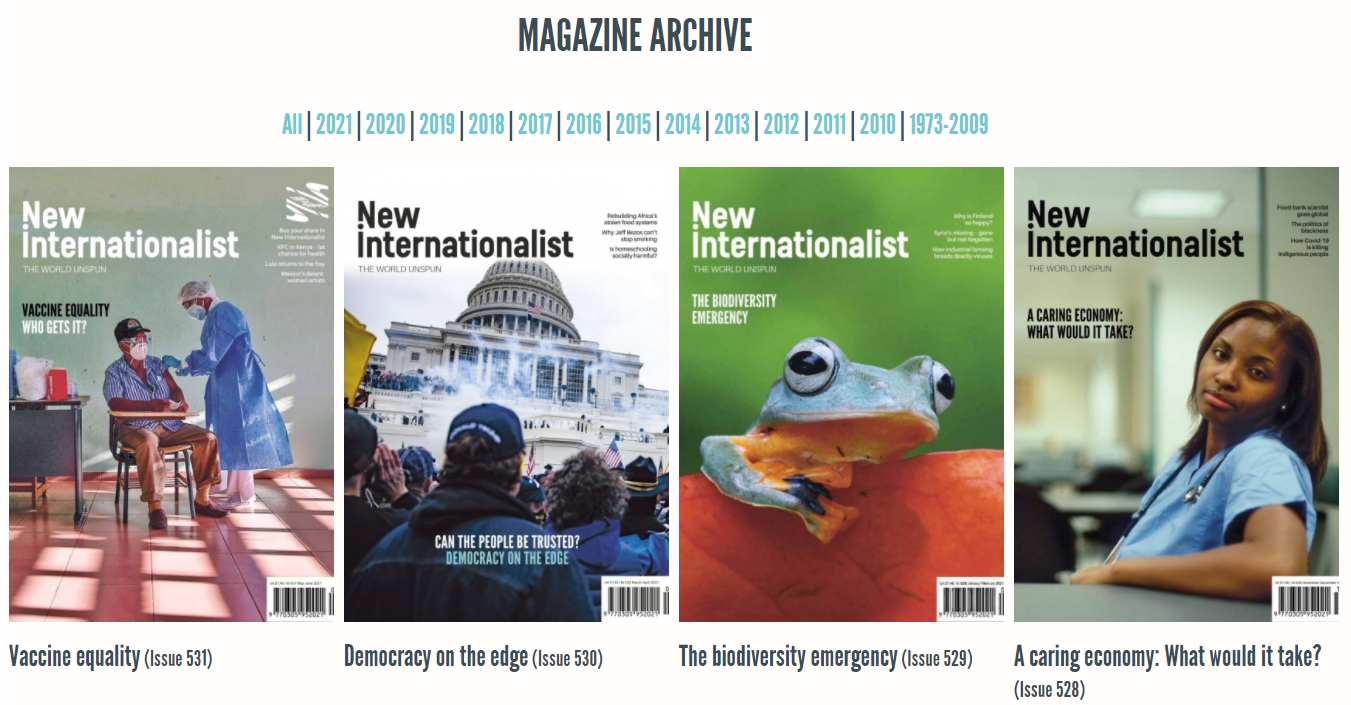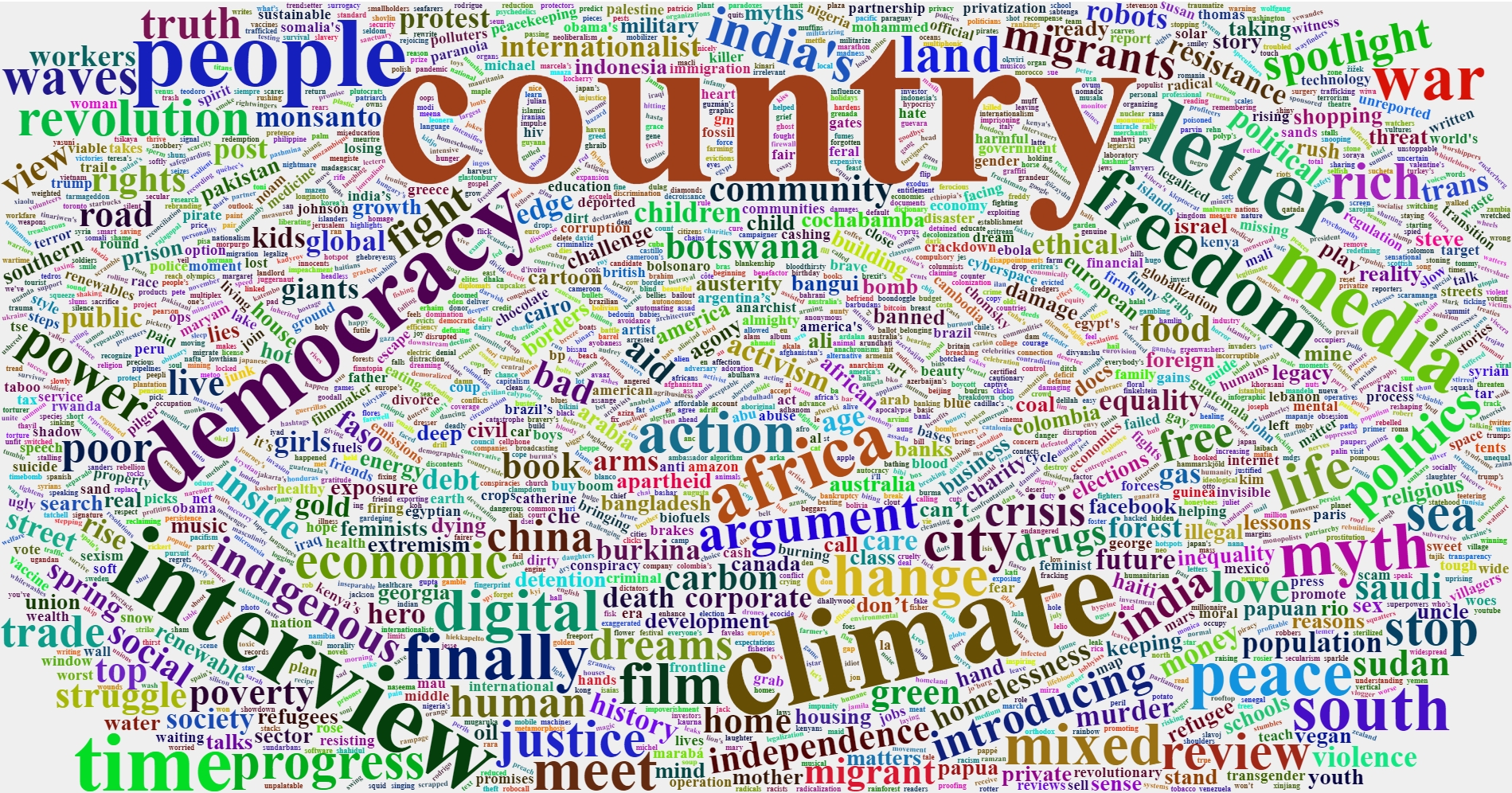Safe the New Internationalist's stories! Using webscraping and word clouds to see why independent journalism is worth protecting!
For nearly 50 years, the UK-based independent magazine New Internationalist is bringing us impactful, global stories from voices often unheard. The magazine is dedicated to socially conscious journalism and publishing and is now inviting the public to support their mission and become one of their co-owners. In this short post, I will be looking at the topics covered in the New Internationalist by scraping their website for article titles of past issues and visualizing the results in a word cloud, all using R.
Rationale and disclaimer
The New Internationalist if currently running a fundraiser where you can become a co-owner of the magazine to save its survival in these challenging times for independent journalism. While this fundraiser is the focus of this post, this has certainly been its motivation!
 New Internationalist logo.
New Internationalist logo.
First a quick disclaimer, though, so we area ll on the same page: I am in no way affiliated with the New Internationalist nor do I have any financial interest in the organization. I am, however, a subscriber of the magazine and truly believe in their approach to journalism, their ethics, their storytelling and their record of supporting issues I deeply care about. I think, it is immensely important to support independent journalism - now more than ever! That’s why I decided to have a quick look at which topics the New Internationalist has been covering in the last decade. And maybe, this might convince you to check out their current fundraiser and read up on their mission and goals for the future. With just one week left in their campaign, they are about one-third shy from their ultimate funding goal of 350,000 GBP. So, let me convince you that the topics they’re covering make it worthwhile supporting them, if you can.
For that, I will be using the R package rvest to iteratively scrape their website for all article headlines of the past 11 years that are available online. Once I have all the article headlines, I will visualize them in a word cloud using the wordcloud2 package.
So, let’s get started.
Scraping the New Internationalist website for article headlines
The first step is to scrape the New Internationalist online magazine archive for article headlines. Looking at their website structure, I decided to use the three-step approach to achieve this:
- Scrape the links from their
/magazinessubpage to the overview of the respective issues for that particular year. - Follow these links and scrape the links for each issue’s table of content.
- Follow that link and scrape the article headlines for each issue.
 Screenshot of the New Internationalist magazine archive.
Screenshot of the New Internationalist magazine archive.
Using the rvest package similar to the link-follow-then-scrape method described by Jerid Francom allows us to extract a certain CSS element of the website. Contrary to the Jerid’s methods of using a for loop to iterate over all detected elements (i.e. links), I will use the map() function to serially apply the html scraping functions of rvest.
The CSS patterns to follow were identified using the Selector Gadget browser plugin (I am using the Chrome browser) and are stored in the respective xxx_selector variable. As mentioned earlier, I use a step-wise approach to extract the article headlines by first finding the page where all issues for a given year are located, then following the links to the table of content for each issue und finally, extracting the article headlines from all these pages. Thus is how it looks in code:
# Load libraries
#==================================
library(tidyverse)
library(stringr)
library(rvest)
# Set variables
#==================================
base_url = "https://newint.org"
year_url = paste0(base_url, "/magazines/")
year_selector = ".magazines-year a"
issue_selector = ".story-card__title a"
article_selector = "#block-views-magazine-articles-block a"
# Find available years
#==================================
newint_years =
tibble(years_html = map(year_url, read_html)) %>%
mutate(years_nodes = map(years_html, html_nodes, year_selector),
year = map(years_nodes, html_text),
years_url = map(years_nodes, html_attr, "href")) %>%
unnest(c(year, years_url)) %>%
#clean data formatting and filter for years after 2010
mutate(year = str_trim(year)) %>%
filter(year %in% 2010:2021) %>%
mutate(years_url = paste0(base_url, years_url)) %>%
select(year, years_url)
# Find all issues per year
#==================================
newint_issues =
newint_years %>%
mutate(issue_html = map(years_url, read_html),
issue_nodes = map(issue_html, html_nodes, issue_selector),
issue_title = map(issue_nodes, html_text),
issue_url = map(issue_nodes, html_attr, "href")) %>%
unnest(c(issue_title, issue_url)) %>%
mutate(issue_url = paste0(base_url, issue_url)) %>%
select(year, issue_title, issue_url)
# Find all article headlines
#==================================
newint_articles =
newint_issues %>%
mutate(article_html = map(issue_url, read_html),
article_nodes = map(article_html, html_nodes, article_selector),
article_title = map(article_nodes, html_text)) %>%
unnest(article_title) %>%
# remove duplicate article titles
group_by(article_title) %>%
mutate(count = n()) %>%
ungroup() %>%
filter(count == 1) %>%
select(year, issue_title, article_title)
We now have a data frame which contains the year, issue title and all unique article titles of the New Internationalist from 2010 to 2021. We had to remove duplicate article titles as to not skew the word count data to recurring themes like book, film or music reviews or columns which often have identical titles over several issues.
head(newint_articles)
# A tibble: 6 x 3
year issue_title article_title
<chr> <chr> <chr>
1 2021 Vaccine equality The nuts and bolts
2 2021 Vaccine equality How to end vaccine apartheid
3 2021 Vaccine equality A history of vaccines
4 2021 Vaccine equality Dreams of magic bullets
5 2021 Vaccine equality New Internationalist: the first 50 years – and the next
6 2021 Vaccine equality 5 very good reasons to invest in New Internationalist
Tokenizing the article titles and creating a word cloud
Before we make the word cloud, we have to tokenize the article titles using the tidytext package, which basically means that we split the complete titles into separate words. We also will remove numbers (think titles like “7 great reasons why you should save independent journalism!”) and so-called stop words (like “and”, “or”, “I” etc.) from the titles. After we have tokenized the titles, we also calculate the absolute frequency (i.e. number of occurrences) for each word. This frequency will then determine how large the respective word will be printed in the word cloud.
# Load libraries
#==================================
library(tidytext)
# Tokenize article titles
#==================================
newint_words =
newint_articles %>%
#remove numbers
mutate(article_tidy = gsub("[[:digit:]]+", "", article_title)) %>%
#tokenize text and remove stopwords
unnest_tokens(word, article_tidy) %>%
filter(!word %in% stop_words$word) %>%
ungroup() %>%
#calclulate frequencies
group_by(word) %>%
summarize(freq = n()) %>%
ungroup()
This gives us a data frame with two columns, one for each unique word and one for the respective frequency. Let’s look at the top ten:
head(newint_words[order(newint_words$freq, decreasing = TRUE), ], 10)
# A tibble: 10 x 2
word freq
<chr> <int>
1 country 30
2 profile 28
3 climate 17
4 world 15
5 interview 14
6 democracy 13
7 people 13
8 letter 12
9 media 11
10 time 11
For readers of the New Internationalist it won’t come as a surprise that the words country and profile come in first and second, as most issues feature so-called Country Profiles in which a given country is characterized and some facts and figures as well as a assessment of freedom of press and the current political and human rights conditions is being presented.
However, issues like the climate, the state of democracy and the media as well as in depth interviews with activists and indigenous land defenders from around the globe are an integral part the New Internationalist’s reporting.
Finally, we can visualize everything in a beautiful word cloud.
# Load libraries
#==================================
library(wordcloud2)
# Create word cloud
#==================================
wordcloud2(data = newint_words,
fontFamily = "serif",
size = 1.6,
backgroundColor = "#eeeee",
color = "random-dark")
 Word Cloud of New Internationalist article titles.
Word Cloud of New Internationalist article titles.
So, if you also feel that these are topics close to your heart, consider supporting the New Internationalist by either taking out or gifting a digital or print subscription or becoming a co-owner by signing shares in their current campaign, if you can. I’d love to see them survive and thrive for many more decades to come.
